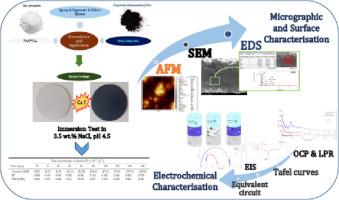求助PDF
{"title":"在3.5 wt.% NaCl和pH为4.5的溶液中加入TiO2和磺基水杨酸掺杂聚邻乙氧基苯胺,增强环氧涂料的耐蚀性能","authors":"Nacer Mounir, Aicha Ziouche, Malha Nazef, Hamid Yousfi","doi":"10.1016/j.ces.2025.122789","DOIUrl":null,"url":null,"abstract":"The present work focuses on the development of advanced epoxy coatings based on poly(o-ethoxyaniline) (POEA) doped with nano-TiO<span><span style=\"\"></span><span data-mathml='<math xmlns=\"http://www.w3.org/1998/Math/MathML\"><msub is=\"true\"><mrow is=\"true\" /><mn is=\"true\">2</mn></msub></math>' role=\"presentation\" style=\"font-size: 90%; display: inline-block; position: relative;\" tabindex=\"0\"><svg aria-hidden=\"true\" focusable=\"false\" height=\"1.509ex\" role=\"img\" style=\"vertical-align: -0.582ex;\" viewbox=\"0 -399.4 453.9 649.8\" width=\"1.054ex\" xmlns:xlink=\"http://www.w3.org/1999/xlink\"><g fill=\"currentColor\" stroke=\"currentColor\" stroke-width=\"0\" transform=\"matrix(1 0 0 -1 0 0)\"><g is=\"true\"><g is=\"true\"></g><g is=\"true\" transform=\"translate(0,-150)\"><use transform=\"scale(0.707)\" xlink:href=\"#MJMAIN-32\"></use></g></g></g></svg><span role=\"presentation\"><math xmlns=\"http://www.w3.org/1998/Math/MathML\"><msub is=\"true\"><mrow is=\"true\"></mrow><mn is=\"true\">2</mn></msub></math></span></span><script type=\"math/mml\"><math><msub is=\"true\"><mrow is=\"true\"></mrow><mn is=\"true\">2</mn></msub></math></script></span> and sulfosalicylic acid (SSA), designed to enhance the corrosion resistance of 420 stainless steel (420SS) compared with conventional zinc phosphate (ZP) coatings. The synthesized coatings were characterized by FTIR spectroscopy, contact angle (CA) measurements, and SEM observations. Their protective performance was further evaluated in a 3.5 wt.% NaCl solution at pH 4.5 using electrochemical techniques, including open-circuit potential (OCP), linear polarization resistance (LPR), potentiodynamic polarization (Tafel curves), electrochemical impedance spectroscopy (EIS), and long-term immersion tests. The POEA-SSA/TiO<span><span style=\"\"></span><span data-mathml='<math xmlns=\"http://www.w3.org/1998/Math/MathML\"><msub is=\"true\"><mrow is=\"true\" /><mn is=\"true\">2</mn></msub></math>' role=\"presentation\" style=\"font-size: 90%; display: inline-block; position: relative;\" tabindex=\"0\"><svg aria-hidden=\"true\" focusable=\"false\" height=\"1.509ex\" role=\"img\" style=\"vertical-align: -0.582ex;\" viewbox=\"0 -399.4 453.9 649.8\" width=\"1.054ex\" xmlns:xlink=\"http://www.w3.org/1999/xlink\"><g fill=\"currentColor\" stroke=\"currentColor\" stroke-width=\"0\" transform=\"matrix(1 0 0 -1 0 0)\"><g is=\"true\"><g is=\"true\"></g><g is=\"true\" transform=\"translate(0,-150)\"><use transform=\"scale(0.707)\" xlink:href=\"#MJMAIN-32\"></use></g></g></g></svg><span role=\"presentation\"><math xmlns=\"http://www.w3.org/1998/Math/MathML\"><msub is=\"true\"><mrow is=\"true\"></mrow><mn is=\"true\">2</mn></msub></math></span></span><script type=\"math/mml\"><math><msub is=\"true\"><mrow is=\"true\"></mrow><mn is=\"true\">2</mn></msub></math></script></span> epoxy system exhibited significantly higher corrosion resistance (5-fold), corrosion current density reduced by 50-fold, impedance increased by 100% than ZP, mainly due to the formation of a stronger passivation layer and the contribution of an auxiliary cathodic process between the emeraldine and leuco forms of POEA. Overall, the results highlight the potential of POEA-SSA/TiO<span><span style=\"\"></span><span data-mathml='<math xmlns=\"http://www.w3.org/1998/Math/MathML\"><msub is=\"true\"><mrow is=\"true\" /><mn is=\"true\">2</mn></msub></math>' role=\"presentation\" style=\"font-size: 90%; display: inline-block; position: relative;\" tabindex=\"0\"><svg aria-hidden=\"true\" focusable=\"false\" height=\"1.509ex\" role=\"img\" style=\"vertical-align: -0.582ex;\" viewbox=\"0 -399.4 453.9 649.8\" width=\"1.054ex\" xmlns:xlink=\"http://www.w3.org/1999/xlink\"><g fill=\"currentColor\" stroke=\"currentColor\" stroke-width=\"0\" transform=\"matrix(1 0 0 -1 0 0)\"><g is=\"true\"><g is=\"true\"></g><g is=\"true\" transform=\"translate(0,-150)\"><use transform=\"scale(0.707)\" xlink:href=\"#MJMAIN-32\"></use></g></g></g></svg><span role=\"presentation\"><math xmlns=\"http://www.w3.org/1998/Math/MathML\"><msub is=\"true\"><mrow is=\"true\"></mrow><mn is=\"true\">2</mn></msub></math></span></span><script type=\"math/mml\"><math><msub is=\"true\"><mrow is=\"true\"></mrow><mn is=\"true\">2</mn></msub></math></script></span> modified epoxy coatings as durable protective layers for 420SS, offering a practical alternative to conventional ZP for storage tanks operating in acidic salt environment.","PeriodicalId":271,"journal":{"name":"Chemical Engineering Science","volume":"19 1","pages":""},"PeriodicalIF":4.3000,"publicationDate":"2025-10-18","publicationTypes":"Journal Article","fieldsOfStudy":null,"isOpenAccess":false,"openAccessPdf":"","citationCount":"0","resultStr":"{\"title\":\"Enhancement of the corrosion barrier properties of epoxy coatings through the incorporation of TiO2 and Sulfosalicylic acid doped poly(o-ethoxyaniline) applied onto 420SS in 3.5 wt.% NaCl solution with pH 4.5\",\"authors\":\"Nacer Mounir, Aicha Ziouche, Malha Nazef, Hamid Yousfi\",\"doi\":\"10.1016/j.ces.2025.122789\",\"DOIUrl\":null,\"url\":null,\"abstract\":\"The present work focuses on the development of advanced epoxy coatings based on poly(o-ethoxyaniline) (POEA) doped with nano-TiO<span><span style=\\\"\\\"></span><span data-mathml='<math xmlns=\\\"http://www.w3.org/1998/Math/MathML\\\"><msub is=\\\"true\\\"><mrow is=\\\"true\\\" /><mn is=\\\"true\\\">2</mn></msub></math>' role=\\\"presentation\\\" style=\\\"font-size: 90%; display: inline-block; position: relative;\\\" tabindex=\\\"0\\\"><svg aria-hidden=\\\"true\\\" focusable=\\\"false\\\" height=\\\"1.509ex\\\" role=\\\"img\\\" style=\\\"vertical-align: -0.582ex;\\\" viewbox=\\\"0 -399.4 453.9 649.8\\\" width=\\\"1.054ex\\\" xmlns:xlink=\\\"http://www.w3.org/1999/xlink\\\"><g fill=\\\"currentColor\\\" stroke=\\\"currentColor\\\" stroke-width=\\\"0\\\" transform=\\\"matrix(1 0 0 -1 0 0)\\\"><g is=\\\"true\\\"><g is=\\\"true\\\"></g><g is=\\\"true\\\" transform=\\\"translate(0,-150)\\\"><use transform=\\\"scale(0.707)\\\" xlink:href=\\\"#MJMAIN-32\\\"></use></g></g></g></svg><span role=\\\"presentation\\\"><math xmlns=\\\"http://www.w3.org/1998/Math/MathML\\\"><msub is=\\\"true\\\"><mrow is=\\\"true\\\"></mrow><mn is=\\\"true\\\">2</mn></msub></math></span></span><script type=\\\"math/mml\\\"><math><msub is=\\\"true\\\"><mrow is=\\\"true\\\"></mrow><mn is=\\\"true\\\">2</mn></msub></math></script></span> and sulfosalicylic acid (SSA), designed to enhance the corrosion resistance of 420 stainless steel (420SS) compared with conventional zinc phosphate (ZP) coatings. The synthesized coatings were characterized by FTIR spectroscopy, contact angle (CA) measurements, and SEM observations. Their protective performance was further evaluated in a 3.5 wt.% NaCl solution at pH 4.5 using electrochemical techniques, including open-circuit potential (OCP), linear polarization resistance (LPR), potentiodynamic polarization (Tafel curves), electrochemical impedance spectroscopy (EIS), and long-term immersion tests. The POEA-SSA/TiO<span><span style=\\\"\\\"></span><span data-mathml='<math xmlns=\\\"http://www.w3.org/1998/Math/MathML\\\"><msub is=\\\"true\\\"><mrow is=\\\"true\\\" /><mn is=\\\"true\\\">2</mn></msub></math>' role=\\\"presentation\\\" style=\\\"font-size: 90%; display: inline-block; position: relative;\\\" tabindex=\\\"0\\\"><svg aria-hidden=\\\"true\\\" focusable=\\\"false\\\" height=\\\"1.509ex\\\" role=\\\"img\\\" style=\\\"vertical-align: -0.582ex;\\\" viewbox=\\\"0 -399.4 453.9 649.8\\\" width=\\\"1.054ex\\\" xmlns:xlink=\\\"http://www.w3.org/1999/xlink\\\"><g fill=\\\"currentColor\\\" stroke=\\\"currentColor\\\" stroke-width=\\\"0\\\" transform=\\\"matrix(1 0 0 -1 0 0)\\\"><g is=\\\"true\\\"><g is=\\\"true\\\"></g><g is=\\\"true\\\" transform=\\\"translate(0,-150)\\\"><use transform=\\\"scale(0.707)\\\" xlink:href=\\\"#MJMAIN-32\\\"></use></g></g></g></svg><span role=\\\"presentation\\\"><math xmlns=\\\"http://www.w3.org/1998/Math/MathML\\\"><msub is=\\\"true\\\"><mrow is=\\\"true\\\"></mrow><mn is=\\\"true\\\">2</mn></msub></math></span></span><script type=\\\"math/mml\\\"><math><msub is=\\\"true\\\"><mrow is=\\\"true\\\"></mrow><mn is=\\\"true\\\">2</mn></msub></math></script></span> epoxy system exhibited significantly higher corrosion resistance (5-fold), corrosion current density reduced by 50-fold, impedance increased by 100% than ZP, mainly due to the formation of a stronger passivation layer and the contribution of an auxiliary cathodic process between the emeraldine and leuco forms of POEA. Overall, the results highlight the potential of POEA-SSA/TiO<span><span style=\\\"\\\"></span><span data-mathml='<math xmlns=\\\"http://www.w3.org/1998/Math/MathML\\\"><msub is=\\\"true\\\"><mrow is=\\\"true\\\" /><mn is=\\\"true\\\">2</mn></msub></math>' role=\\\"presentation\\\" style=\\\"font-size: 90%; display: inline-block; position: relative;\\\" tabindex=\\\"0\\\"><svg aria-hidden=\\\"true\\\" focusable=\\\"false\\\" height=\\\"1.509ex\\\" role=\\\"img\\\" style=\\\"vertical-align: -0.582ex;\\\" viewbox=\\\"0 -399.4 453.9 649.8\\\" width=\\\"1.054ex\\\" xmlns:xlink=\\\"http://www.w3.org/1999/xlink\\\"><g fill=\\\"currentColor\\\" stroke=\\\"currentColor\\\" stroke-width=\\\"0\\\" transform=\\\"matrix(1 0 0 -1 0 0)\\\"><g is=\\\"true\\\"><g is=\\\"true\\\"></g><g is=\\\"true\\\" transform=\\\"translate(0,-150)\\\"><use transform=\\\"scale(0.707)\\\" xlink:href=\\\"#MJMAIN-32\\\"></use></g></g></g></svg><span role=\\\"presentation\\\"><math xmlns=\\\"http://www.w3.org/1998/Math/MathML\\\"><msub is=\\\"true\\\"><mrow is=\\\"true\\\"></mrow><mn is=\\\"true\\\">2</mn></msub></math></span></span><script type=\\\"math/mml\\\"><math><msub is=\\\"true\\\"><mrow is=\\\"true\\\"></mrow><mn is=\\\"true\\\">2</mn></msub></math></script></span> modified epoxy coatings as durable protective layers for 420SS, offering a practical alternative to conventional ZP for storage tanks operating in acidic salt environment.\",\"PeriodicalId\":271,\"journal\":{\"name\":\"Chemical Engineering Science\",\"volume\":\"19 1\",\"pages\":\"\"},\"PeriodicalIF\":4.3000,\"publicationDate\":\"2025-10-18\",\"publicationTypes\":\"Journal Article\",\"fieldsOfStudy\":null,\"isOpenAccess\":false,\"openAccessPdf\":\"\",\"citationCount\":\"0\",\"resultStr\":null,\"platform\":\"Semanticscholar\",\"paperid\":null,\"PeriodicalName\":\"Chemical Engineering Science\",\"FirstCategoryId\":\"5\",\"ListUrlMain\":\"https://doi.org/10.1016/j.ces.2025.122789\",\"RegionNum\":2,\"RegionCategory\":\"工程技术\",\"ArticlePicture\":[],\"TitleCN\":null,\"AbstractTextCN\":null,\"PMCID\":null,\"EPubDate\":\"\",\"PubModel\":\"\",\"JCR\":\"Q2\",\"JCRName\":\"ENGINEERING, CHEMICAL\",\"Score\":null,\"Total\":0}","platform":"Semanticscholar","paperid":null,"PeriodicalName":"Chemical Engineering Science","FirstCategoryId":"5","ListUrlMain":"https://doi.org/10.1016/j.ces.2025.122789","RegionNum":2,"RegionCategory":"工程技术","ArticlePicture":[],"TitleCN":null,"AbstractTextCN":null,"PMCID":null,"EPubDate":"","PubModel":"","JCR":"Q2","JCRName":"ENGINEERING, CHEMICAL","Score":null,"Total":0}
引用次数: 0
引用
批量引用
Enhancement of the corrosion barrier properties of epoxy coatings through the incorporation of TiO2 and Sulfosalicylic acid doped poly(o-ethoxyaniline) applied onto 420SS in 3.5 wt.% NaCl solution with pH 4.5
The present work focuses on the development of advanced epoxy coatings based on poly(o-ethoxyaniline) (POEA) doped with nano-TiO2 2 2


 求助内容:
求助内容: 应助结果提醒方式:
应助结果提醒方式:


